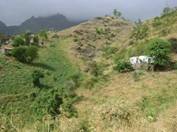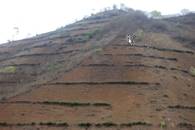Site selection
Like other Sahelian countries, Cape Verde suffers from the catastrophic effects of drought, though in a more aggravated manner. The climate, characterized by extremely insufficient and irregular rainfall, combined with the small land size and high propensity to soil erosion, are the main causes of the structural weakness of the agriculture sector.
The main characteristic of the archipelago is the extreme irregularity of precipitations. The succession of long dry periods, alternated with brief wetter periods is a characteristic of the Cape Verde climate. Frequent droughts and consequent crises (disaster, famines) have been registered and are recurrent in the history of the people republic of Cape Verde. However, the resulting effects of the droughts of the past years have been felt in a particular way, taking into account the strong demographic pressure over the scarce natural resources.
Cape Verde history is full of dramatic events of scarcity and famines responsible for the death of thousands of peoples. From the XVI to the XIX centuries, the islands' administrations registered at least 27 famines and epidemics. Between 1900 and 1948, 6 famines occurred, with a loss of more than 75000 souls. In 1950, the total number of inhabitants was less than 200,000 in the entire archipelago. Despite the close relation between the famines and the occurrence of dry years, other factors contributed to the high number of deaths, which in the 1947-1948 famine killed 1 in every 5 inhabitant in Cape Verde. In the 1940s, the famines were responsible for the death of almost half of the population of Cape Verde. Amaral (1964) refers that in the Santiago Island alone, the population decreased by 65% in the 1947-1948 crises. The chronic malnutrition induced the occurrence of epidemics and death, and anthropophagic cases occurred during the famine crisis.
From the 1950s onwards, Cape Verde has been considered an example on how to manage harsh conditions. The inclusion of Cape Verde in the DESIRE project is therefore important as this is providing a complete setup, from political, socio-economic, soil and water conservation dimensions to compare with other desertification prone regions. Despite the fragile environment and the increasing demographic pressure, Cape Verde built the structures that allow the country to overcome extreme drought events without loss of human lives.
 |
 |
 |
Figure 3: Rainfed agriculture in Longueira catchment Humid zone (photo by J. Tavares in 2009 |
Figure 4: Combination between rainfed agriculture and green belt terraces in Godim catchment after harvesting crop -Semi arid zone. (photo by J. Tavares in 2008) |
Figure 5: Irrigated lands in Jaracunda - arid littoral zone (photo by J. Tavares in 2005) |
The Ribeira Seca basin has for several years been a study area for various programs and projects in the fight against land and water degradation. One of the reasons for the great interest in the Ribeira Seca basin is that the land degradation is considered severe due to the practice of rainfed agriculture, which facilitates and increases soil erosion, and the irrigated agriculture which aggravates the soil and water salinization downstream. Due to the interesting results that were achieved in the earlier projects, the socio-economic and ecological importance of the basin (it comprises all the Santiago bio-climatic areas), and the severe population pressure upon the natural resources, Ribeira Seca was selected as a study site for the DESIRE project.